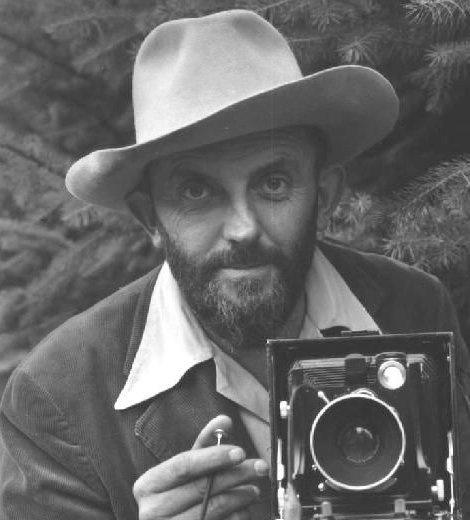
Quick Wiki
- Full Name Ansel Easton Adams
- Occupation Photographer
- Nationality American
- Birthplace Western Addition, San Francisco, California
- Birth Date February 20, 1902
- Death Date April 22, 1984
- Age At Death 82
Ansel Adams | Biography
Adams’ Works remain Central in the Realm of Photography and Nature ConservationAdams’ pictures have also become a significant part of the American Conservation Movement. They have set a reminder that the beauty of the wild needs to be preserved. His collection was popularized around the globe, which helped the wildlands of America to be conserved and promoted.
When photography was taken primarily as a medium of documentation, Ansel Adams approached it as a form of art. Ansel Adams was the most prominent landscape photographer in America’s history. His photographs were well recognized for exploring the untouched wonders of nature.
The artist mainly captured the beauty of national parks and many wildlands of the American West in his bold, emotive, and emphatic style. His passion for photography and conserving the wilderness has primarily contributed to the preservation of several areas by spreading awareness and influencing the consciousness of Americans.
Through his work, he urged the viewers to explore and protect the splendor of nature.
Early Life & Family
Ansel Easton Adams was born on 20 February 1902 to a businessman, Charles Adams, and his wife, Olive Bray, in San Francisco, California. He was a grandson of a wealthy lumber business owner.
At the age of four, he injured his nose in an incident in the San Francisco earthquake of 1906. His nose was never fixed for the remainder of his life.
As an introverted boy with a rebellious personality, Adams couldn’t fit in at school. In addition, his shy nature restrained him from making many friends. As a consequence, he was homeschooled by his family and private tutors from the age of 12.
Yosemite National Park
A self-taught pianist, Adams believed music to be his early ambition. But when he received his first-ever camera, he drifted his attention away from music in favor of photography. Later, Adams started creating astounding photographs in 1916 following a visit to Yosemite National Park. He also began studying darkroom techniques and attending art exhibits to understand photography at a greater depth.
During the 1920s, the Sierra Club in Yosemite National Park hired Adams as a custodian. This part of his life would play a crucial role in his early accomplishments as he would take many of his first, yet famous, photographs then.
In the year of 1922, his photographs were published for the first time in the Sierra Club’s 1922 Bulletin. A few years later, he exhibited his works at the club’s headquarters in San Francisco.
Career & Development In Style
To further pursue his interest and passion, Adams began working a commercial job in 1929. The move would prove to be a stepping-stone for his career. An establishment called Yosemite Park and Curry Company hired him for the position of marketing photographer. During this time, Adams took dozens of pictures of captivating landscapes and people celebrating their vacation at the park. He would do so with careful composition and technical preciseness that would later help define photography as an art form.
In 1930, Adams crossed paths with the American photographer Paul Strand, who introduced him to Strand’s new style of negatives in New Mexico. The minimalism of Strand’s concept and their radiant tonality drew his interest in this particular style. This technique contrasted with the pictorialism approach used by several contemporary artists. With a shift to a more realistic style, the experience created a breakthrough in Adams’ career.
Hoping to further photography as an art form, Adams founded Group f.64 in 1932 with Edward Weston and Imogen Cunningham. Only then, he began promoting straight photography— an approach to capture subjects in intricate details and sharp focus.
Work on Wilderness
Similarly, Adams, along with photographers Dorothea Lange and Walker Evans, committed to bringing political and social change through their art. His first purpose was to protect the wilderness of Yosemite and other areas. Describing his muse for Yosemite, he once said, “Yosemite Valley, to me, is always a sunrise, a glitter of green and golden wonder in a vast edifice of stone and space.”
By the 1940s, Adams’ work, along with other prominent figures such as Alfred Stieglitz, Dorothea Lange, and Walker Evans, finally led the way for photography to be recognized as an art form.
Besides this, Adams’ pictures have also become a significant part of the American Conservation Movement. They have set a reminder that the beauty of the wild needs to be preserved. His collection was popularized around the globe, which helped the wildlands of America to be conserved and promoted.
Later Career and Death
Adams continued printing negatives to satisfy the huge demand for his spellbinding pictures throughout the 1970s. During this time, he would also spend most of his time reinterpreting his previous work.
He later published several books in his later years discussing the art of photography and the aim of creating awareness to protect the wilderness. Among the most notable works was a book titled ‘This Is the American Earth (1960),’ published by the Sierra Club.
In 1980, the acclaimed photographer was awarded the Presidential Medal of Freedom by President Jimmy Carter. The president made a note of the influence of his work on the general public, stating, “It is through (Adams’s) foresight and fortitude that so much of America has been saved for future Americans.”
On 22 April 1984, Adams passed away from a heart attack at the age of 82. While his works were admired throughout his lifetime, his photographs have become highly sought-after since his death. Reminisced for his distinctive style and enduring influence on art, Adams’ works remain central to the contributions in the realm of photography and nature conservation.
